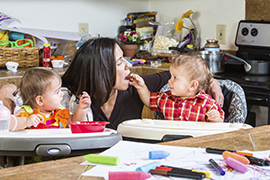Home visitors: Support children by supporting their parents
When parents' emotional tanks are refueled, they have more energy to respond to their child's needs
Filling up the family’s emotional tank
AT THE BEGINNING OF THE VISIT
Geneel begins the session by saying, “Emma, I was thinking about you this week. I remembered how excited you were last time with Evelyn’s progress and her interest in looking at pictures, pretending to eat the food in the pictures. You were going to practice ‘reading’ to her again this week. Tell me how it went.”
DURING THE VISIT
Bryan works with William on interacting more with his baby. During a diaper change, William begins to play a game with Evan to keep him distracted. He flips him over from side to side in between caring for Evan. Evan squeals in delight. Bryan notes afterward, “Evan really likes to play with you and you found a way to help him learn how to roll over at the same time you did a diaper change. That makes changing a diaper a pretty fun activity. Great idea!”
SUMMARIZING THE VISIT
At the end of the home visit, Susan summarizes what was discussed with Carol by saying, “You asked about finding a different place to live today. We talked about the different options and you decided to talk with your current landlord about changing apartments. We practiced what you might say, and you sounded pretty confident about how to ask for what you need. You really know what’s best for your family and how to get that in a respectful way.”
IN BETWEEN VISITS
Rebecca runs into Samantha who has a WIC appointment in the same building as the home visiting office. Samantha tells Rebecca she realized she could check board books out from the library after Anthony had enjoyed them so much during their last visit. She shows Rebecca the books they’d just checked out, and Rebecca responds, “What a great idea you had to get more books from the library so you and Anthony can read together!”

 Parents who trust and feel supported by the home visitor are more likely to become engaged and continue the work needed to make changes for their children
Parents who trust and feel supported by the home visitor are more likely to become engaged and continue the work needed to make changes for their children